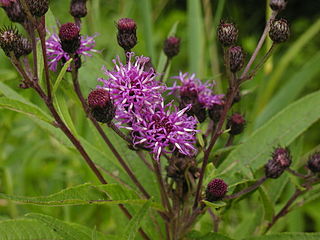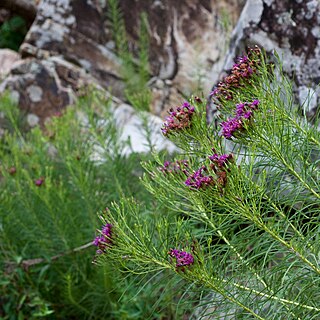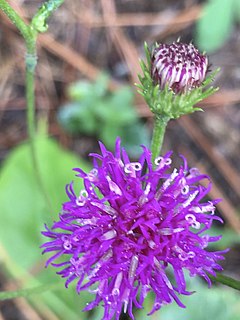
Vernonia is a genus of about 350 species of forbs and shrubs in the family Asteraceae. Some species are known as ironweed. Some species are edible and of economic value. They are known for having intense purple flowers. The genus is named for the English botanist William Vernon. There have been numerous distinct subgenera and subsections named in this genus, and some botanists have divided the genus into several distinct genera. For instance, the Flora of North America recognizes only about twenty species in Vernoniasensu stricto, seventeen of which are in North America north of Mexico, with the others being found in South America.

Vernonia galamensis is a plant in the sunflower family, known for its use as an oilseed. This species, often called ironweed, is the largest source of vernonia oil, which is rich in a useful epoxy fatty acid called vernolic acid and is used to make plastics, rubbery coatings, and drying agents. Use of this oil as a replacement for traditional plasticizers and binders in the production of paints and PVC shows promise as a method of reducing smog pollution.
Fleabane is a common name for some flowering plants in the family Asteraceae.

Vernolic acid (leukotoxin) is a long chain fatty acid that is monounsaturated and contains an epoxide. It is the R,R-cis epoxide derived from the C12–C13 alkene of linoleic acid. Vernolic acid was first definitively characterized in 1954. It is a major component in vernonia oil, which is produced in abundance by the genera Vernonia and Euphorbia and is a potentially useful biofeedstock.

Vernonia noveboracensis is a plant in the daisy family, Asteraceae. It is native to the eastern United States, from Florida to Massachusetts and west to Tennessee, Alabama, and West Virginia and to southern Ontario.

Hellinsia paleaceus is a moth of the family Pterophoridae described by Philipp Christoph Zeller in 1873. It is found in North America, including Florida, Mississippi Maryland, Montana, Texas, California, Nebraska, New Mexico and south-eastern Canada. It has also been recorded from Puerto Rico.

Vernonia gigantea is a species of perennial plant from family Asteraceae found in United States and Canada. The plant is native to the eastern United States, north to New York state and Ontario, and southwest to Texas.

Vernonia missurica, the Missouri ironweed, is a species of purple-flowered perennial plant from family Asteraceae found growing in the central United States.

Vernonia arkansana is a species of perennial plant from family Asteraceae found in south-central United States. The plant is 4–6 feet (1.2–1.8 m) high and 3–4 feet (0.91–1.22 m) wide. The flowers bloom from August to September and are pink-purple coloured. It is a recipient of the Royal Horticultural Society's Award of Garden Merit.
Ironweed or iron weed may refer to:

Cyanthillium cinereum is a species of perennial plants in the sunflower family. The species is native to tropical Africa and to tropical Asia and has become naturalized in Australia, Mesoamerica, tropical South America, the West Indies, and the US State of Florida.

Vernonia lettermannii, the narrowleaf ironweed, is a plant species known only from Arkansas and Oklahoma. It grows on floodplains and terraces at elevations of 100–200 m (330–660 ft).
Tall ironweed is a common name for several plants and may refer to:

Vernonia baldwinii, the western ironweed or Baldwin's ironweed, is a perennial herb native to central North America.

Vernonia lindheimeri, commonly known as woolly ironweed, is a species of flowering plant in the aster family (Asteraceae). It is native North America, where it is native to the state of Coahuila in Mexico and to the state of Texas in the United States. Its natural habitat is in open, calcareous areas.

Vernonia texana, commonly called Texas ironweed, is a species of flowering plant in the aster family (Asteraceae). It is native eastern to North America, where it is found primarily in the South Central region of the United States. Its natural habitat is in open sandy woodlands.

Vernonia acaulis is a species of perennial plant from family Asteraceae. It is native to the U.S.A.
Vernonia flaccidifolia is a species of flowering plant in the family Asteraceae. It is native to Georgia, Tennessee, and Alabama.

Vernonia fasciculata, the smooth ironweed or common ironweed, or prairie ironweed is a species of perennial plant from family Asteraceae. It is native to Manitoba in Canada and the north-central U.S.A.
















